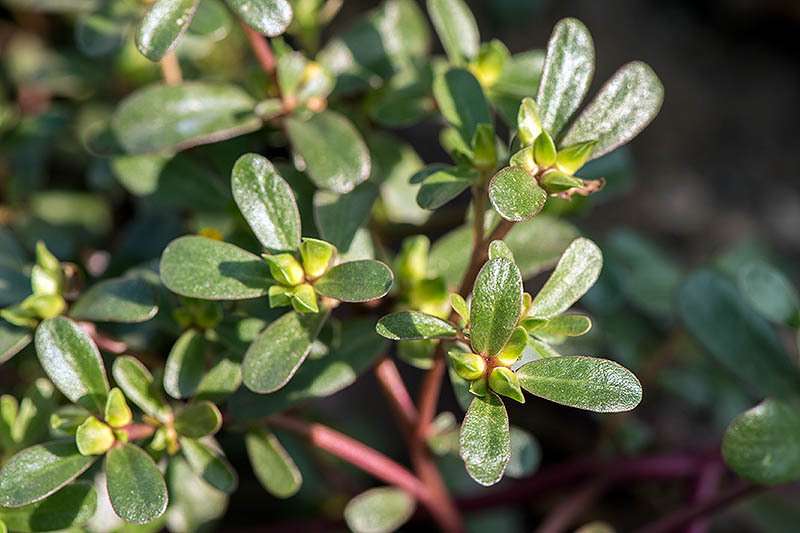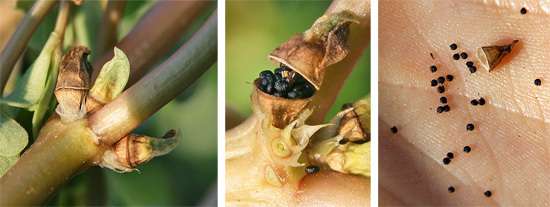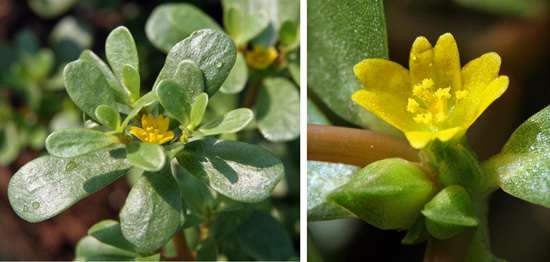Low in fat, cholesterol, sodium, and carbohydrates, high in potassium, protein, vitamin A (seven times more beta carotene than carrots!), vitamin C, and Omega-3 fatty acids, and containing eight essential amino acids and antioxidant flavonoids and polysaccharides used in therapy for Parkinson’s, Alzheimer’s, and type 2 diabetes, this superfood has it all. Additionally, lab tests show that a compound of this plant helps kill liver cancer cells and plant seed extracts are active against brain and lung cancer cells. Best of all, this plant tastes yummy with a slightly citrusy, salty, with a peppery kick and a juicy crunchy texture. You can eat the leaves, stems, flowers, and seeds, either raw or cooked.
Common Purslane has been consumed for thousands of years in the Mediterranean, Mid East, Asia, and by the indigenous North Americans both fresh, cooked, and juiced or decocted as medicines. In spite of all the beneficial health uses and time-worn testing, common purslane has been called “a noxious weed” by the USDA.

Common Purslane (Portulaca oleracea) also known as hogweed, pigweed and pusley, is an annual succulent that looks like a tiny jade plant with alternating leaf clusters at stem joints. Each fleshy, flat green leaf is oval to spoon-shaped and broadest near the rounded tip. The half-inch wide small yellow flowers that bloom midsummer through early fall, have five notched petals. The flowers blossom at the stem joints, with just a single bloom opening at a time.
Purslane is propagated from seed, stem cuttings, divisions of root systems, and transplanting them. One plant can produce over 50,000 seeds. Seeds remain viable in the soil for several decades. Decades!! Purslane seeds can be sown outside after the last frost by sprinkling them onto moist soil and pressing them in lightly. As a cutting, each piece of stem can create a new plant. To propagate a stem cutting, cut a six-inch long stem and remove the leaves from the bottom half. Plant the stem in soil with half the stem underground in an area with bright, indirect light and keep the soil moist.

Purslane loves full sun and our Oklahoma heat. A good place to plant them is next to walls or fences which reflect heat. Plus, they are not picky about soil. As a weed, these plants can be found easily growing in sidewalk cracks and on the side of the road. But if you are growing purslane for food, these will grow larger, juicier plants in loamy, porous soil without much water.
Harvest mature leaves about 50 days after you plant the seeds. Cut a single stem at a time or most of the plant. Leave about 2 inches above the soil and it will regrow. Oddly enough, the time of day that you harvest makes a difference in the flavor. Plants harvested in the morning taste tart and the evening cuttings have a sweeter flavor. Stems can be stored in the refrigerator for up to a week in a plastic bag.
Purslane can be dried and used as a dried herb or like cornstarch thickener. Some cooks serve purslane steamed like spinach. A refreshing way to enjoy purslane is in a salad.
So, you decide – Super Food or Super Weed?






